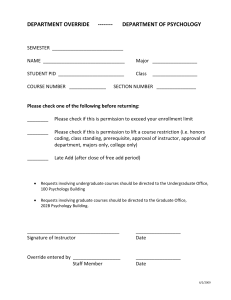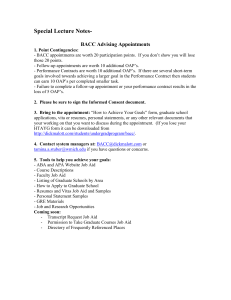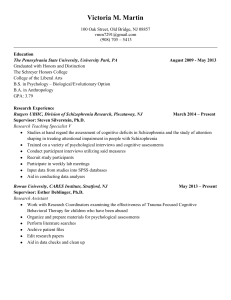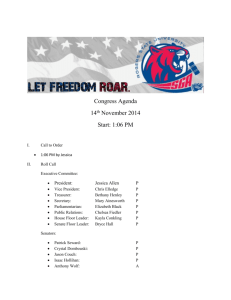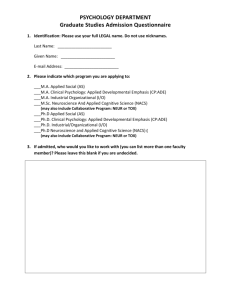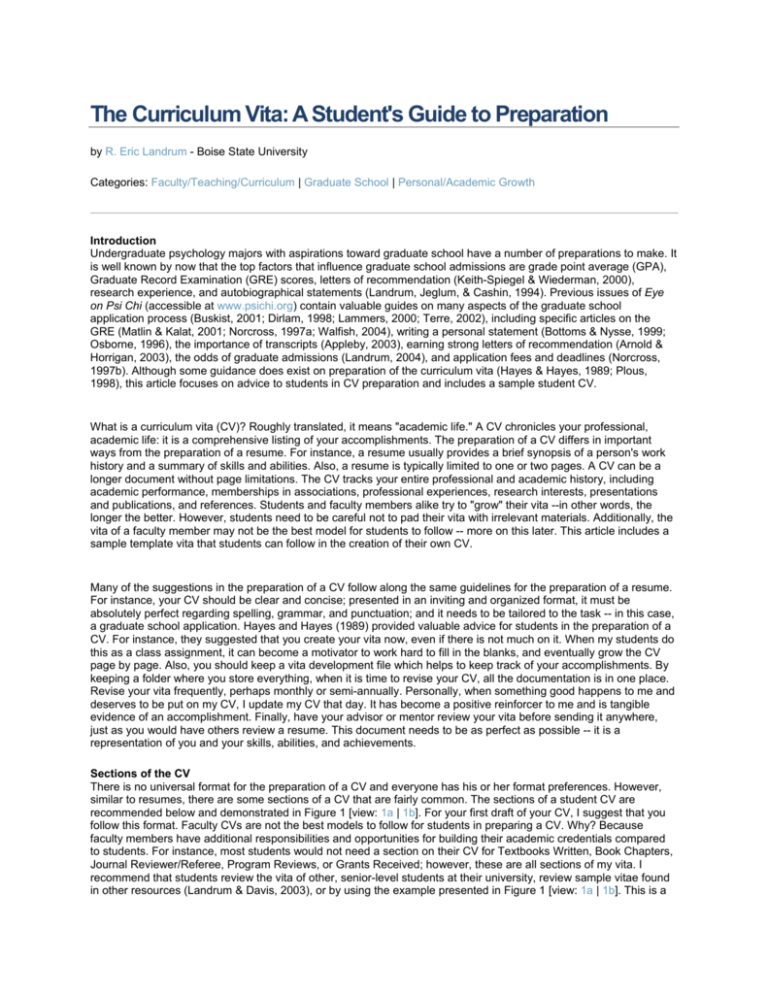
The Curriculum Vita: A Student's Guide to Preparation
by R. Eric Landrum - Boise State University
Categories: Faculty/Teaching/Curriculum | Graduate School | Personal/Academic Growth
Introduction
Undergraduate psychology majors with aspirations toward graduate school have a number of preparations to make. It
is well known by now that the top factors that influence graduate school admissions are grade point average (GPA),
Graduate Record Examination (GRE) scores, letters of recommendation (Keith-Spiegel & Wiederman, 2000),
research experience, and autobiographical statements (Landrum, Jeglum, & Cashin, 1994). Previous issues of Eye
on Psi Chi (accessible at www.psichi.org) contain valuable guides on many aspects of the graduate school
application process (Buskist, 2001; Dirlam, 1998; Lammers, 2000; Terre, 2002), including specific articles on the
GRE (Matlin & Kalat, 2001; Norcross, 1997a; Walfish, 2004), writing a personal statement (Bottoms & Nysse, 1999;
Osborne, 1996), the importance of transcripts (Appleby, 2003), earning strong letters of recommendation (Arnold &
Horrigan, 2003), the odds of graduate admissions (Landrum, 2004), and application fees and deadlines (Norcross,
1997b). Although some guidance does exist on preparation of the curriculum vita (Hayes & Hayes, 1989; Plous,
1998), this article focuses on advice to students in CV preparation and includes a sample student CV.
What is a curriculum vita (CV)? Roughly translated, it means "academic life." A CV chronicles your professional,
academic life: it is a comprehensive listing of your accomplishments. The preparation of a CV differs in important
ways from the preparation of a resume. For instance, a resume usually provides a brief synopsis of a person's work
history and a summary of skills and abilities. Also, a resume is typically limited to one or two pages. A CV can be a
longer document without page limitations. The CV tracks your entire professional and academic history, including
academic performance, memberships in associations, professional experiences, research interests, presentations
and publications, and references. Students and faculty members alike try to "grow" their vita --in other words, the
longer the better. However, students need to be careful not to pad their vita with irrelevant materials. Additionally, the
vita of a faculty member may not be the best model for students to follow -- more on this later. This article includes a
sample template vita that students can follow in the creation of their own CV.
Many of the suggestions in the preparation of a CV follow along the same guidelines for the preparation of a resume.
For instance, your CV should be clear and concise; presented in an inviting and organized format, it must be
absolutely perfect regarding spelling, grammar, and punctuation; and it needs to be tailored to the task -- in this case,
a graduate school application. Hayes and Hayes (1989) provided valuable advice for students in the preparation of a
CV. For instance, they suggested that you create your vita now, even if there is not much on it. When my students do
this as a class assignment, it can become a motivator to work hard to fill in the blanks, and eventually grow the CV
page by page. Also, you should keep a vita development file which helps to keep track of your accomplishments. By
keeping a folder where you store everything, when it is time to revise your CV, all the documentation is in one place.
Revise your vita frequently, perhaps monthly or semi-annually. Personally, when something good happens to me and
deserves to be put on my CV, I update my CV that day. It has become a positive reinforcer to me and is tangible
evidence of an accomplishment. Finally, have your advisor or mentor review your vita before sending it anywhere,
just as you would have others review a resume. This document needs to be as perfect as possible -- it is a
representation of you and your skills, abilities, and achievements.
Sections of the CV
There is no universal format for the preparation of a CV and everyone has his or her format preferences. However,
similar to resumes, there are some sections of a CV that are fairly common. The sections of a student CV are
recommended below and demonstrated in Figure 1 [view: 1a | 1b]. For your first draft of your CV, I suggest that you
follow this format. Faculty CVs are not the best models to follow for students in preparing a CV. Why? Because
faculty members have additional responsibilities and opportunities for building their academic credentials compared
to students. For instance, most students would not need a section on their CV for Textbooks Written, Book Chapters,
Journal Reviewer/Referee, Program Reviews, or Grants Received; however, these are all sections of my vita. I
recommend that students review the vita of other, senior-level students at their university, review sample vitae found
in other resources (Landrum & Davis, 2003), or by using the example presented in Figure 1 [view: 1a | 1b]. This is a
more appropriate template for potential student achievement. Below are brief descriptions of the major sections of
your CV.
1) Contact Information. Display your name at the top of your CV in large letters. Include your current contact
information: mailing address, email address, telephone number, and fax number, if applicable. Be sure that your
answering machine message is professional sounding, and that your email address is not cutesy (not
flirtygirl@hotmail.com or hottiedude@yahoo.com). Avoid giving a cell phone number as your telephone number. If
you get a call from a graduate admissions committee member, you'll want absolute clarity and to be in an
environment with minimal distractions.
2) Educational History. Recount your educational history here, starting from the beginning. That is, if you transferred
to your current school, list your schools in order starting from the first school attended with dates (if there is a gap in
your education, you'll have a chance to explain that in your cover letter). State the degree you have earned (or are
about to earn): a bachelor of arts or bachelor of science degree. If you have not yet graduated, make this clear -state that your graduation date is "expected" or "anticipated." Always remember to be fair with the data and don't
claim to have a degree that you have not yet earned. Also, state your cumulative GPA. If your school requests it, you
might list your GPA in psychology and your last two years' GPA.
3) Professional Experience. Here, you want to list any academic or employment experiences that are directly
related to your graduate school aspirations. If you were a teaching assistant or research assistant, list each of those
experiences here. If you had any jobs that are psychology-related, you can list them here. If you are unsure if you
should include a particular job, consult with a trusted faculty member. For each experience, list the supervisor, dates
of participation, and a brief description of the job duties performed (these brief descriptions do not need to be
complete sentences).
4) Presentations and Publications. This is a section where it is particularly important to be fair with the data. If you
have only conference presentations, then only use the heading "Presentations." If you have both presentations and
publications, list them separately under two categories. A common mistake (one made even by graduate students
applying for faculty positions) is to "hide" lack of achievement in one category by grouping both of these categories
together. Present your presentations and publications using APA format, except use single-spacing. If a presentation
or publication is submitted but not yet accepted, say so. Papers that are "in preparation" or "in progress" need to be
clearly labeled as such--resist all effort to pad your CV in any area.
5) Honors, Awards, and Memberships. In this section, list any academic honors and awards you have earned
including Dean's List, scholarships, and other awards. Also, if you are a member of Psi Chi, list that here! If you have
served in a leadership role for any campus organizations, be sure to list that. If you have joined any regional
psychology associations, list your student memberships here.
6) References. Here, you should list at least three references who can speak to your academic skills and abilities. In
general, this should be at least two psychology faculty members. You can also include one internship supervisor or
one job supervisor (as long as your job is psychology-related). If you are a transfer student, limit yourself to only one
reference from your former institution. Make sure you have asked the faculty for permission to list them as a
reference, and let them know when your graduate school materials are being sent (more than likely, these are your
letters of recommendation writers as well).
Conclusions
It is not necessary to follow this format precisely, but the above sections should act as an overview for what can be
included in a student CV. Be sure to consult with your mentor or other trusted faculty members for advice on what to
include on your CV, and for formatting tips. Additionally, make sure that multiple people proofread your CV for you; it
must be absolutely perfect before being sent anywhere. Fairly or unfairly, your CV is a representation of you. If this
document is prepared in a sloppy and unprofessional manner, you will be perceived as sloppy and unprofessional.
Figure 1 should be particularly helpful in giving you ideas on how to prepare your own CV. If you create your first draft
of your CV and it seems a bit short, don't worry--use that observation as a motivator to get more involved outside the
classroom, whether as a teaching or research assistant, Psi Chi, member intern, or by some other means.
The most important thing to remember is to be fair with the data. Don't say that you've done something that you
haven't. Don't say that a manuscript is in press when really it is only submitted. Your reputation and integrity are of
utmost value and once damaged, they are hard to repair. Following the advice in this article should lead you to the
creation of a valuable and important document. If you don't have a CV, start yours now!
References
Appleby, D. C. (2003, Winter). What does your transcript say about you, and what can you do if it says things you
don't like. Eye on Psi Chi, 7(2), 19-21.
Arnold, K. L., & Horrigan, K. L. (2002, Fall). Gaining admission into the graduate program of your choice. Eye on Psi
Chi, 7(1), 30-33.
Bottoms, B. L., & Nysse, K. L. (1999, Fall). Applying to graduate school: Writing a compelling personal statement.
Eye on Psi Chi, 4(1), 20-22.
Buskist, W. (2001, Spring). Seven tips for preparing a successful application to graduate school in psychology. Eye
on Psi Chi, 5(3), 32-34.
Dirlam, D. K. (1998, Fall). Applications that make the schools you want, want you. Eye on Psi Chi, 3(1), 29-30.
Hayes, L. J., & Hayes, S. C. (1989, September). How to apply to graduate school. Retrieved September 28, 1998, at
http://psych.hanover.edu/handbook/applic2.html
Keith-Spiegel, P., & Wiederman, M. W. (2000). The complete guide to graduate school admission: Psychology,
counseling, and related professions (2nd ed.). Mahwah, NJ: Erlbaum.
Lammers, B. (2000, Spring). Quick tips for applying to graduate school in psychology. Eye on Psi Chi, 4(3), 40-42.
Landrum, R. E. (2004, Spring). New odds for graduate admissions in psychology. Eye on Psi Chi, 8(3), 20-21, 32.
Landrum, R. E., & Davis, S. F. (2003). The psychology major: Career options and strategies for success (2nd ed.).
Upper Saddle River, NJ: Prentice-Hall.
Landrum, R. E., Jeglum, E. B., & Cashin, J. R. (1994). The decision-making processes of graduate admissions
committees in psychology. Journal of Social Behavior and Personality, 9, 239-248.
Matlin, M. W., & Kalat, J. W. (2001, Winter). Demystifying the GRE Psychology Test: A brief guide to students. Eye
on Psi Chi, 5(2), 22-25.
Norcross, J. C. (1997a, Winter). GREs and GPAs: The numbers game in graduate admissions. Eye on Psi Chi, 1(2),
10-11.
Norcross, J. C. (1997b, Fall). How much and when? Application feels and deadlines for graduate psychology
programs. Eye on Psi Chi, 2(1), 18-19.
Osborne, R.E. (1996, Fall). The "personal" side of graduate school personal statements. Eye on Psi Chi, 1(1), 14-15.
Plous, S. (1998). Sample template for creating a vita. Retrieved September 28, 1998, at
http://www.weslyan.edu/spn/vitasamp.htm
Terre, L. (2002, Spring). Applying to graduate school in psychology. Eye on Psi Chi, 6(3), 24-25, 33.
Walfish, S. (2004, Winter). An eye-opening experience: Taking an online practice Graduate Record Examination. Eye
on Psi Chi, 8(2), 18-19, 69.
R. Eric Landrum, PhD, is currently a professor of psychology at Boise State University. He
received his PhD in cognitive psychology (with an emphasis in quantitative methodology) from
Southern Illinois University at Carbondale in 1989. His research interests center around the study
of and understanding of educational issues and identifying those conditions that best facilitate
student learning. He has made over 180 professional presentations at conferences and published
over 50 books, book chapters, or professional articles in scholarly, peer-reviewed journals. He is
the coeditor and author of two chapters in Protecting Human Subjects: Departmental Subject
Pools and Institutional Review Boards (1999, APA Books) and lead author of The Psychology
Major: Career Options and Strategies for Success (2nd ed., 2004, Prentice Hall). He is a member
of the American Psychological Association (Fellow, Division 2), the Midwestern Psychological
Association, and the Rocky Mountain Psychological Association.
____________________________________________
Winter 2005 issue of Eye on Psi Chi (Vol. 9, No. 2, pp. 28-29, 42), published by Psi Chi, The National Honor Society
in Psychology (Chattanooga, TN). Copyright, 2005, Psi Chi, The National Honor Society in Psychology. All rights
reserved.
©2013 Psi Chi - The International Honor Society in Psychology, All Rights Reserved

